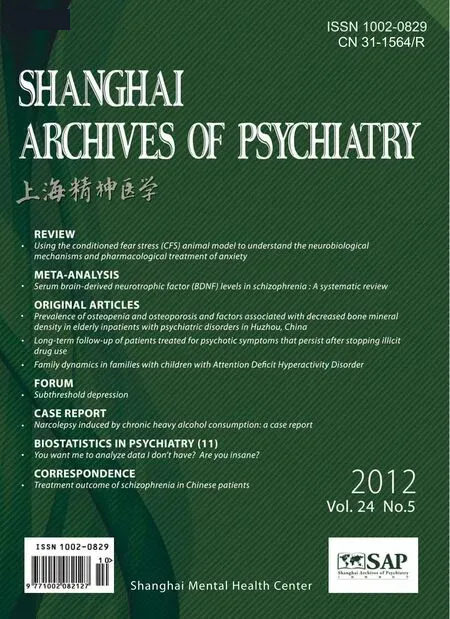Differentiation of various forms of depression
David L. DUNNER*
Differentiation of various forms of depression
David L. DUNNER1,2*
There will likely be a day sometime in the future that psychiatric diagnoses will be made by laboratory tests, as is already the case for many diagnoses in internal medicine. Until that time, however, it is the clinical acumen of the psychiatrist and his or her ability to obtain a complete and accurate history that leads to a diagnosis.
It is very clear that what is considered ‘depression’is a variety of disorders that will likely respond to a variety of treatments. The definition of major depressive disorder is an arbitrary definition which arose from the concept of ‘primary affective disorder’ as developed at Washington University in St. Louis in the 1960s. The criteria for primary affective disorder involved a mood change and a grouping of symptoms that lasted four weeks or longer. It was found that the symptoms differentiated depressed patients from patients with medical and other psychiatric conditions. The use of symptom-based diagnostic criteria was quite novel in psychiatry in the 1960s but this approach became widely accepted and subsequently resulted in the formulation of DSM III. The criteria for major depressive disorder have largely been unchanged since 1980 when DSM III was first published. Other forms of depression, particularly dysthymic disorder, were included in DSM III in order to provide a diagnostic template for various forms of depression which did not meet the precise definition for major depressive disorder. Additional forms of depression, such as recurrent brief depression and minor depression, were also included in DSM III and subsequent revisions, with the provision that further research needed to be done to better define these conditions so that they might be included as distinct entities.
The two forum commentaries published in this issue of theShanghai Archives of Psychiatryby Zhenghui Yi and Yiru Fang[1]and by Jianlin Ji[2]attempt to better define depressions that don’t meet criteria for major depressive disorder. These studies are interesting because they propose changes in how subsyndromal forms of depression are defined. The comment by Yi and Fang cites a study from China which reports that the symptoms of subsyndromal depression in Chinese subjects are somewhat different than those in subjects with typical major depressive disorder and that these subsyndromal symptoms may result in presentation in a medical rather than a psychiatric setting. They also point to the possibility of biological markers to better identify individuals with subsyndromal depression.
Over 40 years ago, Robins and Guze[3]proposed that the differentiation of psychiatric conditions be based on multiple factors. These factors included clinical description, family history, the course of the disorder, treatment response, and biological or laboratory differences. Unfortunately, to date there have been very few biological or laboratory differences that help to differentiate among the psychiatric conditions and thus a clinician must make a clinical decision about how best to classify the disorder that the patient presents with. The comments by Yi and Fang[1]and by Ji[2]on the need to differentiate subsyndromal depressive states are of interest because they highlight the importance of identifying biological markers of these conditions. These efforts to further define subtypes of depression are commendable and illustrate the advances in research that we have experienced since the seminal Robins and Guze article and the development of DSM III.
1. Yi ZH, Fang YR. Are subsyndromal symptomatic depression and major depressive disorder distinct disorders?Shanghai Arch Psychiatry2012; 24 (5): 286-287.
2. Ji JL. Distinguishing sub-clinical (subthreshold) depression from the residual symptoms of major depression.Shanghai Arch Psychiatry2012; 24 (5): 288-289.
3. Robins E, Guze SB. Establishment of diagnostic validity in psychiatric illness: Its application to schizophrenia.Am J Psychiatry1970; 126(7): 983-987.

David L. Dunner
his MD and completed his residency in psychiatry at the Washington University School of Medicine in St. Louis, Missouri. After spending two years at NIMH and eight years at Columbia University, he moved to the University of Washington in Seattle where he developed a clinical trials unit for the study of psychiatric disorders and assumed several positions including Chief of Psychiatry at Harborview Medical Center, Director of the Psychiatry Outpatient Center, and Director of the Center for Anxiety and Depression. Professor Dunner is currently the Director of the Center for Anxiety and Depression in Mercer Island, Washington, and Professor Emeritus at the University of Washington. A member of several scientific organizations and Editor-in-Chief of Comprehensive Psychiatry, Professor Dunner’s research interests focus on psychopharmacological and psychotherapeutic treatments for mood and anxiety disorders.
10.3969/j.issn.1002-0829.2012.05.008
1Center for Anxiety and Depression, Mercer Island, Washington, USA
2Department of Psychiatry and Behavioral Sciences, University of Washington, Seattle, USA
*correspondence: dldunner@comcast.net
- 上海精神醫(yī)學的其它文章
- Treatment outcome of schizophrenia in Chinese patients
- You want me to analyze data I don’t have? Are you insane?
- Narcolepsy induced by chronic heavy alcohol consumption: a case report
- Understanding subthreshold depression
- Distinguishing subclinical (subthreshold) depression from the residual symptoms of major depression
- Are subsyndromal symptomatic depression and major depressive disorder distinct disorders?

